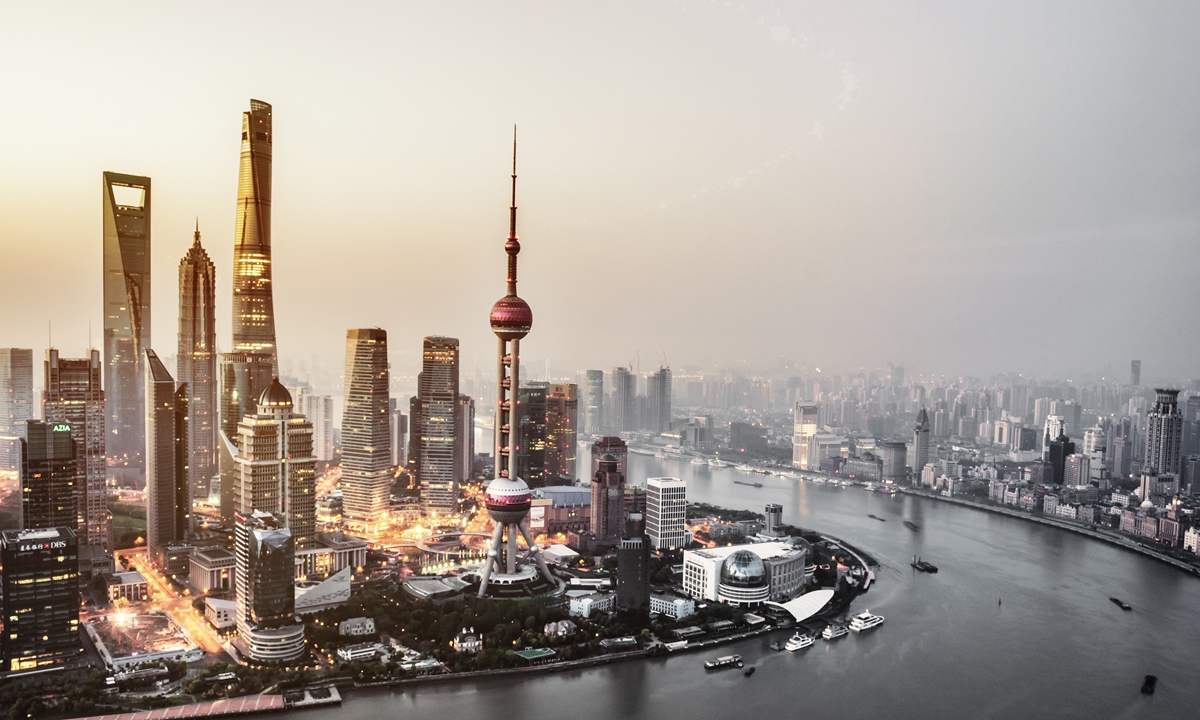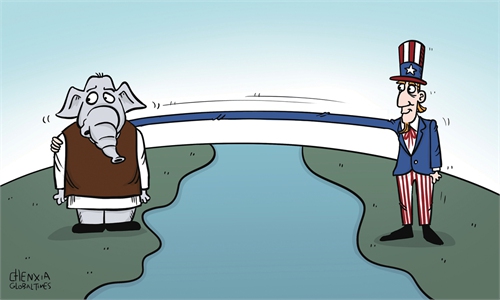Indian elites’ misconception of China exposed in a tweet comparing Prayagraj and Shanghai

Shanghai Photo: VCG
"Shanghai," China's "capital of magic," went viral again on Twitter. Not because of the swift mass COVID-19 testing. This time, it started from an Indian author's video clip of Prayagraj, also known as Allahabad, in the state of Uttar Pradesh, and her tweet, "People will say it is Shanghai, but it is Prayagraj."
The tweet attracted attention because most netizens who have seen it are asking: Which part of the world are you calling Shanghai? The video shows a seemingly high street of the city with excess disco lights, plain buildings mostly two- or three- stories high, a road which looks like a puzzle and some cars parking randomly. The Indian author, Aparna Sinha, seemed quite serious about what she said. If so, it would be a pity that she has never been to Shanghai, and a larger pity that India's "capital of magic" is no more than that.
Unfortunately, the "show off" only unveiled some Indians' overconfidence, ignorance of the real strength of their neighbor China, while unintentionally displaying India's stagnation on development.
Hyping a self-assumed advantage to emphasize how strong India is, while turning a blind eye to India's own mess, have become a trend in Indian society. Thanks to the Indian government's nationalist ruling style, elites and media outlets are stuck in the routine - selectively sensationalizing the seemingly promising part of India, deliberately skirting around severe contradictions and puzzles the country confronts, and constantly throwing mud on its rivals. This gives Indian people an illusion - India is in its moment in the sun. The hard truth is it might be facing one of the most difficult times since its independence.
Since the outbreak of the pandemic, India's economic and social development have been going through retrogression. In May, India's NDTV reported that recording its "worst ever performance in over four decades, India clocked a negative growth of 7.3 percent for 2020-21." Business Insider also noted, "India's GDP has contracted five times since 1947, but never as bad as 7.3 percent."
This is supposed to be a warning that the Indian government's response to COVID-19 is ridiculous and people are suffering. If at this moment, the government, elites and media cannot let go of their vanity, it is India's future they will jeopardize.
The ignorance of reality is misleading India toward making increasingly reckless decisions and misjudgments. Its China policy in recent years is an example. It promoted an economic decoupling from China, without considering its previous reliance on imports from China. As a result, India's domestic supply chains broke down, and New Delhi failed to reach its goal of shifting the global supply chains away from China to India. The border conflict is another example. It is the overconfidence fueled by Hindu nationalism that made India believe that China would indulge India's provocations along the border and the US will firmly back it. Such a mentality eventually turned into a huge blow to China-India ties.
The Indian people's overconfidence will last some time due to the influence of religion and nationalistic politics, but some of them are slowly waking up. The country is now haunted by the raging COVID-19 epidemic, soaring inflation, a surging unemployment rate, constant protests and demonstrations. Some are realizing the harm their ego and ignorance have brought to the country.
As Sinha's tweet shows, Indian people now have a twisted understanding of China. But in this world where every country is connected to each other, there will be a chance for at least some of them to come to China eventually. Once they come, they will see the truth. Some people of insight in India have already started to wonder how much New Delhi will benefit from following Washington's steps so closely to develop such a radical, hostile China policy.
More importantly, what's going on Twitter only mirrors Indian elites' understanding of China. About a billion Indian people, who live in rural areas, are worried about how much they can harvest, whether their children can go to school or if their family can survive this pandemic. In terms of public opinion on ties with China, they are the silent majority.
If India does want to turn the tide of its current difficulties, India politicians, elites and media should make the first step to do something and stop misleading its people. China will grow stronger. This is a fact India cannot resist. If India doesn't want to wake up from its illusion, the gap with China will only widen, like the difference between Prayagraj and Shanghai.
The article is compiled by Global Times reporter based on an interview with Lan Jianxue, head of the Department for Asia-Pacific Studies at China Institute of International Studies. opinion@globaltimes.com.cn

Shanghai Photo: VCG
"Shanghai," China's "capital of magic," went viral again on Twitter. Not because of the swift mass COVID-19 testing. This time, it started from an Indian author's video clip of Prayagraj, also known as Allahabad, in the state of Uttar Pradesh, and her tweet, "People will say it is Shanghai, but it is Prayagraj."
The tweet attracted attention because most netizens who have seen it are asking: Which part of the world are you calling Shanghai? The video shows a seemingly high street of the city with excess disco lights, plain buildings mostly two- or three- stories high, a road which looks like a puzzle and some cars parking randomly. The Indian author, Aparna Sinha, seemed quite serious about what she said. If so, it would be a pity that she has never been to Shanghai, and a larger pity that India's "capital of magic" is no more than that.
Unfortunately, the "show off" only unveiled some Indians' overconfidence, ignorance of the real strength of their neighbor China, while unintentionally displaying India's stagnation on development.
Hyping a self-assumed advantage to emphasize how strong India is, while turning a blind eye to India's own mess, have become a trend in Indian society. Thanks to the Indian government's nationalist ruling style, elites and media outlets are stuck in the routine - selectively sensationalizing the seemingly promising part of India, deliberately skirting around severe contradictions and puzzles the country confronts, and constantly throwing mud on its rivals. This gives Indian people an illusion - India is in its moment in the sun. The hard truth is it might be facing one of the most difficult times since its independence.
Since the outbreak of the pandemic, India's economic and social development have been going through retrogression. In May, India's NDTV reported that recording its "worst ever performance in over four decades, India clocked a negative growth of 7.3 percent for 2020-21." Business Insider also noted, "India's GDP has contracted five times since 1947, but never as bad as 7.3 percent."
This is supposed to be a warning that the Indian government's response to COVID-19 is ridiculous and people are suffering. If at this moment, the government, elites and media cannot let go of their vanity, it is India's future they will jeopardize.
The ignorance of reality is misleading India toward making increasingly reckless decisions and misjudgments. Its China policy in recent years is an example. It promoted an economic decoupling from China, without considering its previous reliance on imports from China. As a result, India's domestic supply chains broke down, and New Delhi failed to reach its goal of shifting the global supply chains away from China to India. The border conflict is another example. It is the overconfidence fueled by Hindu nationalism that made India believe that China would indulge India's provocations along the border and the US will firmly back it. Such a mentality eventually turned into a huge blow to China-India ties.
The Indian people's overconfidence will last some time due to the influence of religion and nationalistic politics, but some of them are slowly waking up. The country is now haunted by the raging COVID-19 epidemic, soaring inflation, a surging unemployment rate, constant protests and demonstrations. Some are realizing the harm their ego and ignorance have brought to the country.
As Sinha's tweet shows, Indian people now have a twisted understanding of China. But in this world where every country is connected to each other, there will be a chance for at least some of them to come to China eventually. Once they come, they will see the truth. Some people of insight in India have already started to wonder how much New Delhi will benefit from following Washington's steps so closely to develop such a radical, hostile China policy.
More importantly, what's going on Twitter only mirrors Indian elites' understanding of China. About a billion Indian people, who live in rural areas, are worried about how much they can harvest, whether their children can go to school or if their family can survive this pandemic. In terms of public opinion on ties with China, they are the silent majority.
If India does want to turn the tide of its current difficulties, India politicians, elites and media should make the first step to do something and stop misleading its people. China will grow stronger. This is a fact India cannot resist. If India doesn't want to wake up from its illusion, the gap with China will only widen, like the difference between Prayagraj and Shanghai.
The article is compiled by Global Times reporter based on an interview with Lan Jianxue, head of the Department for Asia-Pacific Studies at China Institute of International Studies. opinion@globaltimes.com.cn

